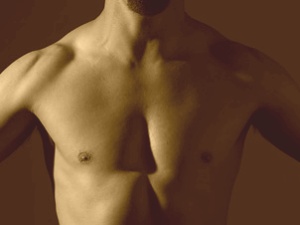
But the inverted nipple bothered him, and with a little googling on internet he learned it was a symptom of breast cancer – in men as well as women. He insisted his doctor for a mammogram, and two days later he learned that he did, in fact, have breast cancer. He’s since had a mastectomy and been treated with chemotherapy.
“Before I went on the Internet, I had no idea men could get breast cancer,” said Fechtner, 51. “I should have known in the back of my mind that it was a possibility. We need to get the message out there to men.”
Male breast cancer is rare less than 1 percent of all breast cancers in the United States are in men, according to the American Cancer Society. But some men may be at greater risk than others of getting cancer – those who carry the breast cancer gene, for example, or who have been exposed to radiation in the chest. And because men aren’t routinely screened for breast cancer, and aren’t often encouraged to perform self-exams, their cancers are usually more advanced by the time they’re diagnosed.
So while breast cancer is much more unusual in men than in women, it’s also deadlier.
“Men present sometimes a little bit later, because they don’t expect breast cancer,” said Dr. Susan Kutner, chairwoman of Kaiser Permanente’s Regional Breast Care Task Force. “They get a lump and they think it’s from something they did. It’s not part of their consciousness that it’s something they’re at risk for.”
Signs may be missed
There are fewer than 2,000 new cases and 450 deaths from breast cancer in men each year, compared to more than 192,000 new cases and 40,000 deaths in women, says the American Cancer Society.
Symptoms of breast cancer in men and women can include dimpling or puckering of the skin on the breast; an inverted nipple, or other changes such as redness or scaling on the nipple; and nipple discharge.
Women are more likely to notice symptoms, if only because they’re usually more body-conscious than men, Kutner said. They see their doctors for regular gynecological visits, when they usually have breast exams, too, and they experience normal hormonal changes that may make them more sensitive to irregularities in their bodies.
Even if they don’t perform regular self- exams, women tend to notice subtle changes in their breasts that men might ignore, Kutner said.
“It’s not a bad idea for men to get used to their bodies, too,” Kutner said. “We know that understanding when your body changes is often the first sign of something.”
Diagnosing breast cancer in men can be easier than in women because male breast tissue isn’t nearly as dense and the cancerous tissue is more obvious, said Dr. Lori Strachowski, chief of women’s imaging at San Francisco General Hospital and an associate clinical professor at UCSF.
Ill at ease
But many men are uncomfortable talking about their breasts, even if something is clearly wrong, and that adds to the difficulty in treating and diagnosing male breast cancer, say doctors.
Men often laugh or make a joke when asked if they’ve ever performed a breast exam or asked their doctor about breast cancer, said Nancy Nick, founder of the John W. Nick Foundation, which raises money for male breast cancer awareness and research.
“Most of them are a little embarrassed when they come in for a mammogram,” said Strachowski.
Fechtner said he wasn’t embarrassed, but he could see how other men might be. He thinks doctors and other health care providers should be sensitive to the specific concerns of men who have been diagnosed with breast cancer.
Awkward in clinics
“Sitting in a mammogram center is a little uncomfortable for a man,” Fechtner said. “If a man is going to be embarrassed, that could be something that prevents him from getting tested.”
The treatment for breast cancer is often the same in men and women, but Fechtner said the clinics themselves were often designed with women in mind.
“I went to this fabulous Kaiser facility in Southern California and they’re showing me their brand new mammogram center, and everything was pink and fluffy,” he said. “When I went in for my surgery they gave out little hand-sewn pillows to put under your arm to support your breast, but it was all decorated with pink hearts or something. Maybe somebody could have made a baseball fabric.”
Male breast cancer risk factors
Age: Men are more likely to get breast cancer in their 60s and 70s.
Family history: About 20 percent of men who get breast cancer have a male or female relative with breast cancer.
Genes: The same genes (BRCA1 and BRCA2) that can mutate and cause breast cancer in women can also cause cancer in men.
Klinefelter syndrome: Men with this congenital condition, which causes men to have more than one X chromosome, may be more likely to develop breast cancer.
Radiation exposure: Men who have been exposed to chest radiation, usually for cancer treatment, have a higher risk of developing breast cancer.
Alcohol and liver disease: Men with severe liver disease, which can be caused by heavy alcohol use, often have higher estrogen levels and may have an increased risk of breast cancer.
Estrogen treatment: Men who have received estrogen as part of treatment for prostate cancer have a slightly increased risk of developing breast cancer, although doctors say the benefits far outweigh the risks.
Obesity: Studies have shown obesity increases the risk of breast cancer in women, and is probably also a risk factor for men.
Source: American Cancer Society